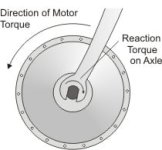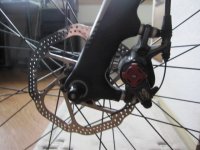Chalo
100 TW
The twist on a hub motor axle is always equal and opposite to the twist the motor puts on the wheel, if that helps you figure it out.
Carbon forks started out with steel steer tubes and aluminum crowns and tip inserts. These days, a carbon fork is likely to be completely made of CFRP-- steer tube, crown, even tips. I imagine that most disc braked carbon forks have a metal insert for attaching the caliper, but I'm not sure of that.
We don't have any busted carbon parts at the shop, but it would be a good idea to keep some around to help demystify the material for people who are curious.
Carbon forks started out with steel steer tubes and aluminum crowns and tip inserts. These days, a carbon fork is likely to be completely made of CFRP-- steer tube, crown, even tips. I imagine that most disc braked carbon forks have a metal insert for attaching the caliper, but I'm not sure of that.
We don't have any busted carbon parts at the shop, but it would be a good idea to keep some around to help demystify the material for people who are curious.





